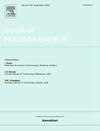熔盐反应堆的综合耗尽代码MACT
IF 2.3
3区 工程技术
Q1 NUCLEAR SCIENCE & TECHNOLOGY
引用次数: 0
摘要
在反应堆设计和分析领域,核素损耗的计算和放射源项的量化是不可缺少的。这些过程的基础是耗竭方程的严格解,这对于获得核素库存的准确测定至关重要。针对液态燃料熔盐堆(MSRs)在线后处理、连续进料和核素迁移的特点,开发了专门用于MSRs的放射源项计算程序MACT。MACT中的耗尽解算法采用了广泛使用的嬗变轨迹分析(TTA)方法和切比雪夫有理逼近法(CRAM)。利用伪衰变常数法、伪核素法和增广矩阵法来处理MSRs的后处理和进料问题。建立了多节点同位素迁移条件下的枯竭模型,并开发了相应的计算模块。最后,通过各种试验对MACT进行了验证,包括Ra-228的衰变、Cr-50的活化、极短寿命裂变产物的试验、U-235热中子裂变的衰变热试验、燃料盐辐照和投料以及多节点核素迁移试验。数值结果表明,MACT在核素库存计算中具有较高的精度,并能很好地处理核反应堆后处理、投料和核素迁移等特点,是核反应堆耗散计算和源项分析的有效工程计算工具。本文章由计算机程序翻译,如有差异,请以英文原文为准。
A comprehensive depletion code MACT for molten salt reactors
In the realm of reactor design and analysis, the computation of nuclide depletion and the quantification of radioactive source terms are indispensable. These processes are underpinned by the rigorous solution of the depletion equation, which are essential for obtaining accurate determinations of nuclide inventories. To address the characteristics of online reprocessing, continuous fuel feeding, and nuclide migration in liquid fuel molten salt reactors (MSRs), a radioactive source term calculation code named MACT has been developed specifically for MSRs. The depletion solution algorithms in MACT employ the widely used Transmutation Trajectory Analysis (TTA) method and the Chebyshev Rational Approximation Method (CRAM). Pseudo-decay constant, pseudo nuclide method, and augmented matrix method are utilized to handle the reprocessing and feeding issues of MSRs. Additionally, a depletion model under multi-node isotopic migration conditions has been established, along with the development of corresponding calculation module. Finally, MACT has been validated through various tests, including the decay of Ra-228, activation of Cr-50, testing of extremely short-lived fission products, decay heat testing of U-235 thermal neutron fission, fuel salt irradiation and feeding, and multi-node nuclide migration tests. Numerical results demonstrate that MACT possesses high precision in nuclide inventory calculations and can easily handle the characteristics of MSR reprocessing, feeding, and nuclide migration, making it a potent engineering calculation tool for depletion calculations and source term analysis in MSRs.
求助全文
通过发布文献求助,成功后即可免费获取论文全文。
去求助
来源期刊

Annals of Nuclear Energy
工程技术-核科学技术
CiteScore
4.30
自引率
21.10%
发文量
632
审稿时长
7.3 months
期刊介绍:
Annals of Nuclear Energy provides an international medium for the communication of original research, ideas and developments in all areas of the field of nuclear energy science and technology. Its scope embraces nuclear fuel reserves, fuel cycles and cost, materials, processing, system and component technology (fission only), design and optimization, direct conversion of nuclear energy sources, environmental control, reactor physics, heat transfer and fluid dynamics, structural analysis, fuel management, future developments, nuclear fuel and safety, nuclear aerosol, neutron physics, computer technology (both software and hardware), risk assessment, radioactive waste disposal and reactor thermal hydraulics. Papers submitted to Annals need to demonstrate a clear link to nuclear power generation/nuclear engineering. Papers which deal with pure nuclear physics, pure health physics, imaging, or attenuation and shielding properties of concretes and various geological materials are not within the scope of the journal. Also, papers that deal with policy or economics are not within the scope of the journal.
 求助内容:
求助内容: 应助结果提醒方式:
应助结果提醒方式:


